DSLR astrophotography with the Astrotrac-Click on image for large version>
Rosette Nebula in hydrogen alpha. Using the the new Astrotrac TT320AG. The setup consist of a Starlight xpress H36 CCD camera, a Canon 400mm L lens at f5.6. For the RA only autoguiding, I mounted in parallel a Borg 50mm with an Orion Starshoot autoguider camera. (Target was 20 degrees above the horizon).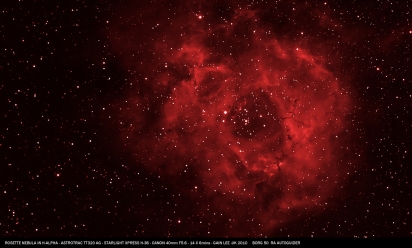
…
The Rosette and Cone nebula. My first attempt with the AstroTrac TT320 AG and the newly modded Canon 50D using a 6nm EOS clip filter I stacked just four frames totalling 20minutes of exposures.
…
A night of meteors with the AstroTrac TT320 AG
A Spring Milkyway from the Comanche Spring Astronomy Campus in Texas tracked with the AstroTrac TT320 AG
Leo Triplet (M65, M66 and N GC 3628) with NGC 3593 with the Canon 50D and 400mm f5.6.
Omega Centauri NGC 5139 with the Canon 50D and 1.4x convertor @ 1100m(Mar 2009)
Venus Takahashi FS 152@3100mm -Astrotrac (06Mar2009)
C/2007 N3 Lulin – First comet with the Astrotrac (01 Mar 2009)
Horsehead and Flame Nebula with Canon 50D (Jan 2009)
M42 at 800mm from Tenerife with the Canon 50D (Jan 2009)
Rosette with Canon 50D (29 Dec 2008)
Rosette nebula and open cluster NGC 2244 with the Canon 50D and 200mm lens.
…
M31 with the Canon 50D (29 Dec 2008)
…
M42 with the Horsehead and Flame – Canon 50D
…
M81 AND M82 AT 1220 MM FOCAL LENGTH (29OCT08)
A first attempt with the heavy 6 inch refractor…
10 X 2.5 minutes at ISO 1000.
SATURN AND THE SHRINKING RINGS (19NOV2008)
A SECOND TIME AT COPERNICUS (23SEP08)
With marginally better seeing and a higher moon..I had a return visit to Copernicus
with the Astrotrac TT320X. Tracking rate set to lunar and working the 4 inch
refractor at 2700mm. 2 short webcam clips acquired, stacked with Registax4 and
merged in Photoshop.>>
ASTROTRAC TT320 X > NGC 891 DEEP SPACE GALAXY HUNTING (04AUG08)
With the Televue NP 101 working at 540mm atop my TT320 X. I captured
20 frames of 85 seconds with an ISO of 1600 on a Canon 5D.
NGC 891 at 30 million light years away is a large edge on spiral galaxy
sporting an obvious dust lane. Behind NGC 891 are some of the
galaxies belonging to the Great Wall, a Supercluster of many thousands
of galaxies between Perseus and Pisces. An immense object measuring
over 500 million light years in diameter. NGC 910 at 200 million light
years distant is an elliptical seen lower right, it is a prominent member
of the galaxy cluster Abell 347. Other galaxies further away at over
500 million light years away can also be seen.
…
FIRST LIGHT > ASTROTRAC TT320 X (AUG08)
As expected, the arrival of the updated X type Astrotrac was followed by nights of
continuous rain and cloud cover. So when the possibility of a short trial came by, I
hurriedly set up the rig and eagerly awaited the anticipated gaps in the cloud base.
By setting the TT320X to track at lunar rate, I set about testing its usefulness on a low
altitude (20-25 deg above the horizon) last quarter moon. The results are below>
click on images for larger preview
Even though I only managed 2 attempts at the moon through poor seeing conditions,
it soon became very clear to me that the new X was tracking the moon perfectly.
…
THE ASTROTRAC TT320
The Astrotrac TT320 is a cool looking very portable well made go anywhere accurate
tracking platform. Designed by Richard Taylor and built in Bristol UK, the TT320 when
coupled with a camera tripod, ball + socket head and a DSLR will allow for as easy as
1-2-3 starscape photography. The device has proven to be an absolute godsend to
astrophotographers like myself.
Living in a heavily populated and immensely light polluted part of the UK, any
deepsky photography has always involved a journey to locations far away from home
( my nearest being my local national park, the Yorkshire Dales at a distance of 55 miles
to various far flung sites around the world). This along with the packing and transporting
of a mass of weighty oversized equipment, and not to mention the long setup and pull
down times has always made me think that this past time is more an extreme sport
than a relaxing hobby. The answer was to find a lightweight, compact and quick to setup
system which would deliver the required results without the need to autoguide;
With the Astrotrac TT320, I feel I’m close to realising the ‘Dream’.
The Virgo galaxy cluster at 40-60 million light years away ( Click on image for large
version). Cropped frame from a Canon 5D and mounted on an Astrotrac TT320.
Over 140 galaxies identified on the original uncropped frame.
Using the Astrotrac is easy. Whilst all those around me are still setting up their
scopes and cameras, I’m already looking at the fruits of my labour on the back of the
camera. Within minutes, I’m up and running making exposures several minutes in length
using various lenses ranging from my 15mm fisheye for all sky panoramas to 4 inch
APO refractors (540mm fl) for a more closeup view. Another added boon is this drive
allows me to use my refractor or solar scope for visual astronomy by keeping the target
centrered in my eyepiece at high powers of magnification.
Over the coming months, I will update this page with more images taken with my
Astrotrac TT320 and comment on its performance.
A DEEP FIELD WITH THE ASTROTRAC TT320
Using my Canon 5D DSLR, Canon EF 200mm f2.8L and Astrotrac TT320 combo.
I took a 3 minute exposure in the region of the Coma galaxy supercluster and
was surprised to see what could be picked up in a single frame. With the lens
stopped down to f4 and camera set to 1000 ISO, the cropped frame can be seen
below. The insets are viewed at 100% magnification from the camera.
Cropped frame from the Canon 5D. NGC 4565 is easily seen at bottom right.
The Coma Galaxy Supercluster at over 300 million light years away
shows easily as a mottling made up of the many hundreds of galaxies
just above centre in this frame. The giant ellipticals NGC 4889, NGC4874
and spiral NGC 4921 are the most prominent objects in the cluster.
Seen edge on, spiral galaxy NGC 4565 is 100,000 light years across
and about 30 million light years away from Earth.
Peculiar spiral galaxy NGC 4725 (lower right). With only one arm, this
galaxy lies 41 million light years away.
Armed with this very portable setup assembled from widely available
off the shelf consumer products, I was astonished at how easy it was
for me to capture galaxies at over 300 million light distance from Earth.
M101 & NGC 5474 WITH A CANON 50D AND 200MM
AN EXPERIMENT > CAN MY ASTROTRAC TRACK?
It was a very hazy summers evening, but I was desperate for an answer.
By adding a 2X teleconvertor to the NP101 4inch refractor, I
realised an instrument working at over 1100mm in focal length. I
managed 6 exposures ranging from 1 to 2.5 minutes before the clouds
rolled in. The result is below, seeing and transparency was very poor,
but not important for this test >
The answer?
YES, the Astrotrac can track!
Astrophotography has never been easier!
Watch this space, more on the way!!!!
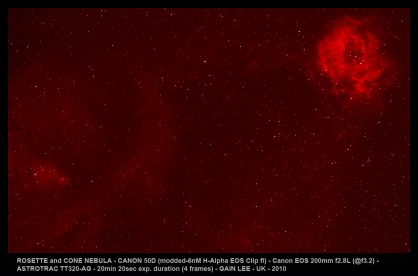


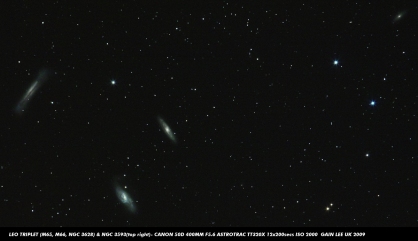
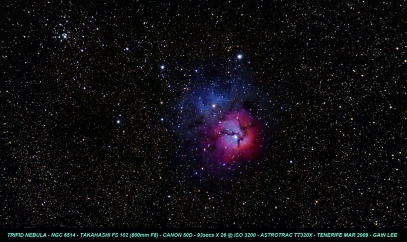


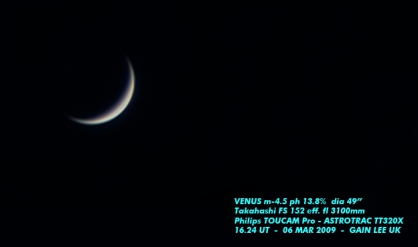


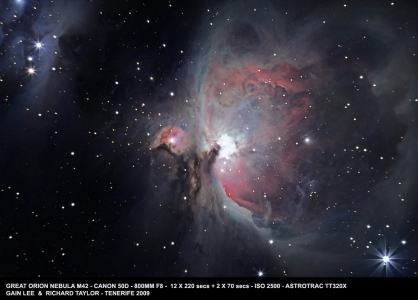



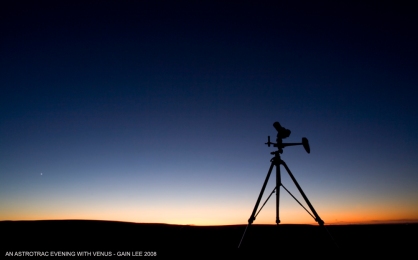

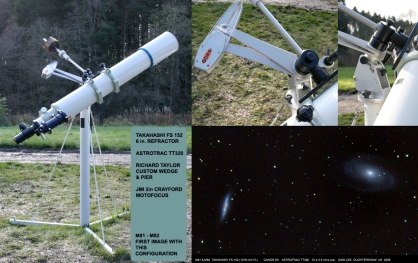

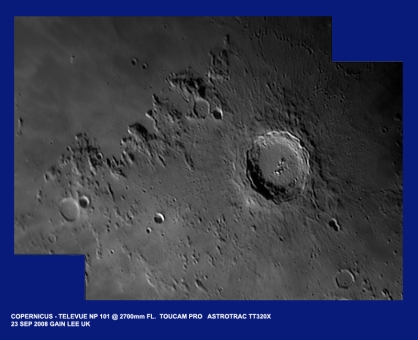
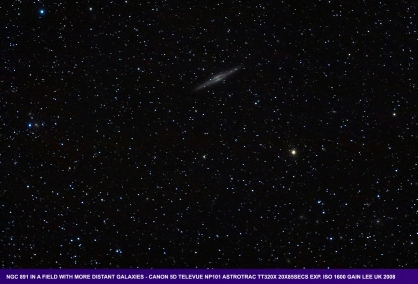
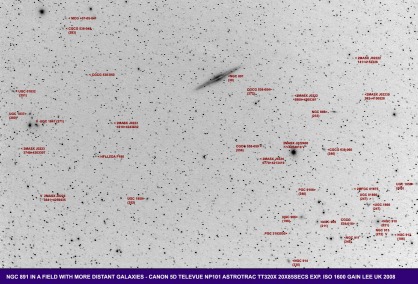
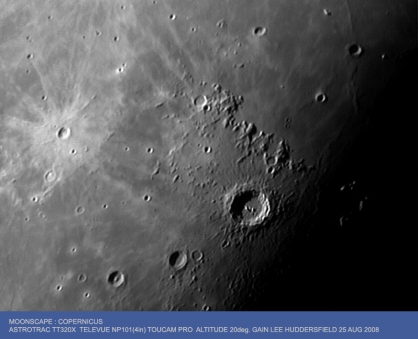
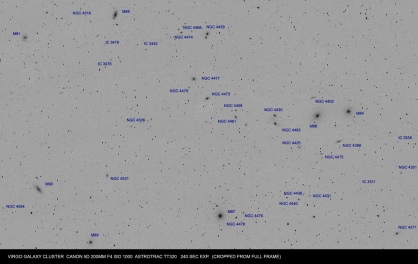
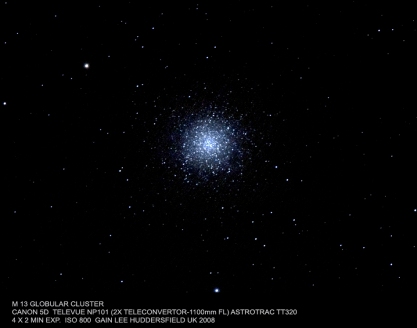
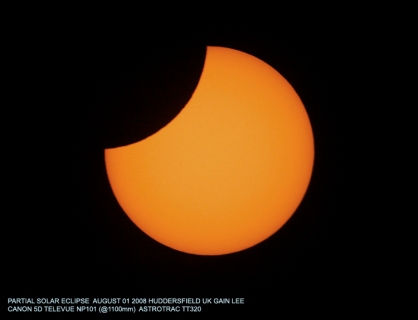
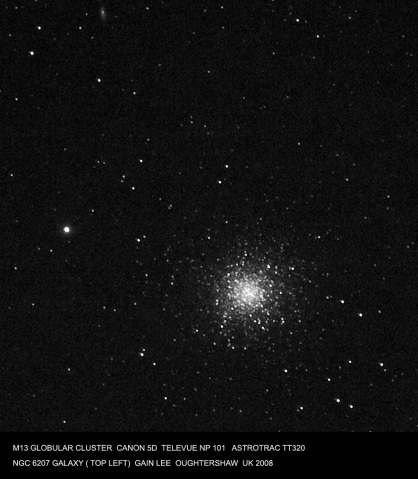
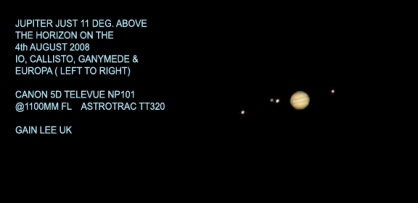

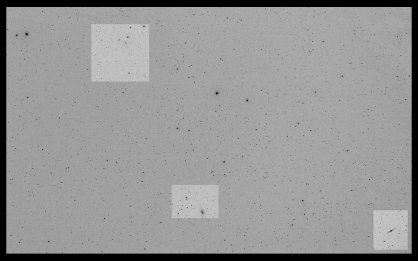

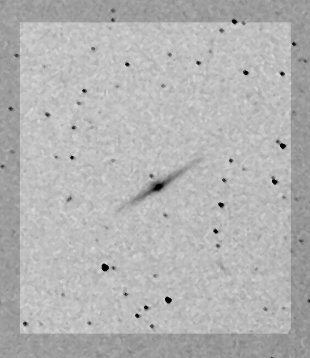
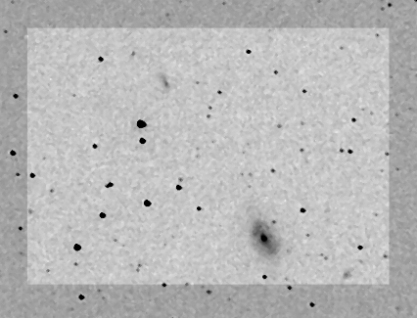
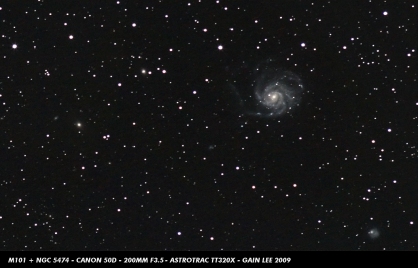

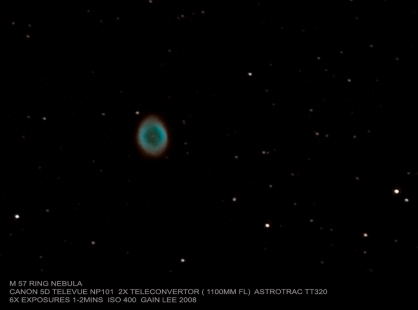


September 15, 2008 at 3:01 am
Hi.
Really nice photos.
I do have one question. In looking at the photos of your setup, what kind of bracket is used to mount your NP101 on the tripod and where did you get it?
Thanks.
Scott
December 7, 2008 at 8:48 pm
hello, Gain some really nice shots their but the best one is the one of the 6” tak on the astrotrak, still makes me laugh. I am still looking for the right object, and i hope to hear from you soon
alasdair
December 31, 2008 at 10:15 am
Lo Gain
Cracking image of the Rosette, how much processing was needed straight out of the camera?
Cheers
Kev
April 20, 2009 at 4:50 pm
Gain,
As a keen photographer I have been reading up on astrophotography and had decided that it involved to much complicated equipment which required storing while not in use. Now that I have seen what is possible with an Astrotrac I think I shall be placing an order soon.
best wishes
Simon
January 14, 2010 at 2:53 am
You have some nice shots here, i will come back later and see what you have captured
October 2, 2010 at 4:44 pm
awesome photos!!! i’m going to buy a canon 50d for christmas and thinking of doing astrophotography as well. is there a telescope under 300$ u can recommend? thanks
October 17, 2010 at 10:11 pm
This is amazing stunning work… congratulations!
I have a 5dmk2 and AT320 as well, but I’m really struggling to get a decent PA. The instructions that accompany the AT are vague at best and I’m not quite up to advanced equatorial setup techniques,(which is why I bought the AT). Do you have any tips you would care to share with a newbie regarding your approach to polar alignment???
Again wonderful images!!!
best,
steve
March 29, 2011 at 1:38 am
Hi Gain
Congratulations for you astrotrac pictures.
When I look at the horsehead nebula taken with the 200mm and the 50D from Tenerife I’m astonished by the tack sharp stellar disks! So, what’s the trick for a perfect focused images? Are you using the live view, a Bathinov mask or what?
Regards
Marco
March 29, 2011 at 8:41 am
Thanks Marco,
I do not use a Bathinov mask. However, for best results, I recommend using ‘Live view’ via a computer screen with magnify turned on.
Clear skies,
Gain
November 26, 2011 at 4:55 pm
[…] sichtbar wurden. Schade aber das Resultat spricht auch so für sich. Allerdings sehe ich noch Verbesserungspotential. Die Aufnahmen mit 5 und 30 Sekunden, rauschen subjektiv stärker als bei 120 Sekunden. Das ist […]
January 8, 2012 at 2:37 am
I am truly astonished at the load the AT can carry and track, all this without the counterbalance bar/weight setup. Superb images with such a simple setup and in Huddersfield! I am ex Leeds – left in 1968 for the pristine atmosphere & climate of Tasmania, with its southern sky objects.
I will bookmark your site and use it as a reference. I have yet to put my AT to good winter use.
Regards & Clear Skies 2012
Shevill
March 31, 2012 at 4:58 pm
Hello Gain,
Terrific photo of the Rosette nebula. How do you manage to centre it in the camera frame? Do you star hop to it or do you have another method of going to an object?
Regards
Neil